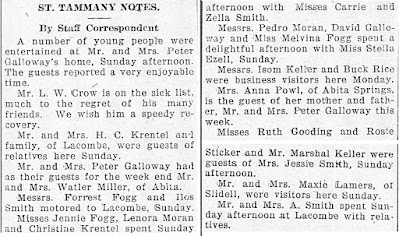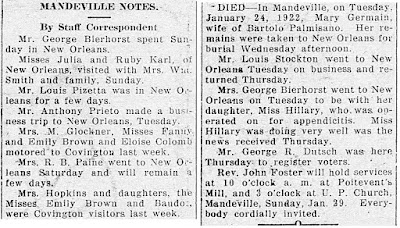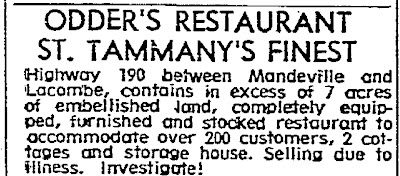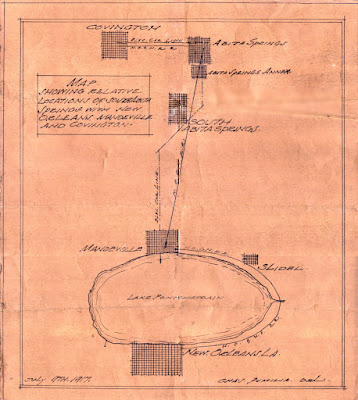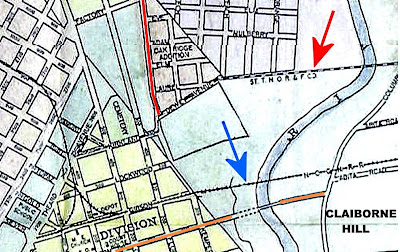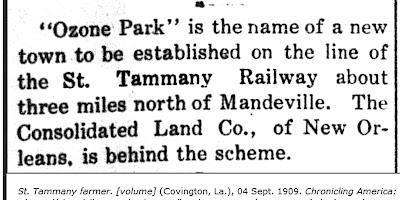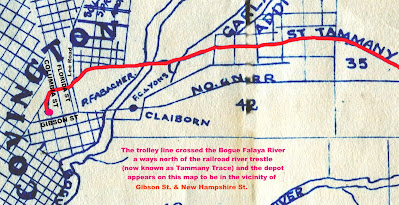Andrella Scorza Morris has been researching her family history for going on 34 years now, and after moving from New Orleans to Slidell 25 years ago, she was surprised to find out that one of her ancestors was connected to manning lighthouses in St. Tammany Parish.
Her great great grandfather, Vincenzo Scorza, was a lighthouse keeper at the mouth of the Tchefuncte River south of Madisonville, and then she found out, much to her surprise, that before that he had manned the lighthouse at Bayou Bonfouca, not far from where she lives today. He was at that lighthouse from 1849 to 1862, and he also owned property near the Bayou Liberty marina close to St. Genevieve Church.
Early photographs of the BonFouca and Tchefuncte River lighthouses
Click on the images to make them larger.
In addition to his lighthouse duties, Vincenzo went on to work for the U.S.
Customs House in New Orleans as an inspector for a few years. He died on a schooner
on his way to his workplace to make a report.
Andrella and her second cousin went to the courthouse in Covington a few years ago where they found a considerable wealth of information about her great great grandfather.
She and other members of the family have worked together for years trying to track down, gather up, and organize the book excerpts, newspaper clippings, and old photos to show the history of the Scorza family through multiple generations. The lighthouse connections have intrigued them.
"So I've become interested in lighthouses, they are my thing now," Andrella said recently. She has been active in genealogy since 1988, and she and other family members have been finding numerous documents involving their ancestors, always on the look out for family photos. She is putting everything in a forthcoming book about the Scorza family.
Before the internet became available, she used to go to the library a lot and look up family records wherever she could find them. She would be visiting graveyards looking up tombstones while her husband would be home watching football on tv, she said.
As time went on, she found out that another great great grandfather of hers was the lighthouse keeper for the Bayou St. John lighthouse.
The Lighthouse Keeper Lifestyle
All the family connections with lighthouses have convinced her to write a book about those individuals who have kept lighthouse lights burning over the decades. The book will show exactly what the lighthouse keepers did on a daily basis, their lifestyles and the importance of what they did. Without lighthouses, many ships would have gone off course, hit the sandbars, and would not have been even able to find the entrances to the bayous they were looking for.
She is searching for a photo of Vincenzo, hoping to add it to the book and family album. She already has a photo of a man standing next to the Tchefuncte River lighthouse, but she doesn't know if it is her great great grandfather or not. If anyone has a photo of one of the Tchefuncte River or Bayou BonFouca lighthouse folks that they know is Vincenzo Scorza, she would appreciate hearing from them.

Her family's past history includes a great uncle from the Marquez side of the family who worked at the Rigolets Angler's Club in September of 1915. Manuel Marquez and his family did not leave the club in the New Orleans east marshlands in time when a major hurricane threatened, and they all were killed by the storm, she said. Twenty three persons died overall there. It was a horrible tragedy that more advanced warnings could have averted.For a more detailed account of that event, CLICK HERE.
The Slidell Magazine Article
In December of 2019, Slidell Magazine ran an article about Andrella's quest for family connections. Written by Charlotte Collins, the article told about the journey that second cousins Andrella and Shelia Lawrence Bercy had already made in researching their family history, an experience that "turned out to be a huge, extended family bonding experience." Here is some information found in that article.
In 1996 Andrella and her husband moved from New Orleans to Slidell following his retirement. As she grew more accustomed to her new home on Cypress Bayou near Coin du Lestin, more and more people would come up to her and tell her that they were related. It prompted her to begin looking into her family heritage as it related to the northshore.
The Lighthouse Keeper
"Andrella had yet to research the Scorza side of her family, her dad's side," the article recounted. "Andrella knew that she also had family in Madisonville, and had heard that her great-great-grandfather on her fathers side, Vincenzo Scorza, was the lighthouse keeper on the Tchefuncte River in Madisonville. He was born in 1797, and died in 1872." In her photo album, Andrella had a photo of that lighthouse, Collins wrote.
According to the Slidell Magazine article, Shelia and Andrella started a Scorza family tree, and they would talk often to share their findings. "We wanted to know more about the Tchefuncte lighthouse and go further into that part of our genealogy studies," Sheila said. To find out more about Vincenzo Scorza, they went to the St. Tammany Parish Courthouse in Covington where they met with Archivist Robin Perkins.
Hitting the Family History Jackpot
Perkins was very helpful in providing the information they were seeking. "She explained to us that she loves lighthouses, and studies the families of the keepers. She had census records. with surnames of Narcisse, Baham, Badon, Doucette, Galatas, Cyprian, LeFrere. Barze, Hessier, and those of family names we didn't know we had!" Shelia is quoted as saying. "We got marriage records and boatloads of information to further our research. But we still were not aware of the Bonfouca lighthouse connection at this time."
Andrella explained that writer Ben Taylor provided much written information about their lighthouse keeper ancestor, and more details were found in the book Keepers of the Light published by the Lake Pontchartrain Basin Maritime Museum. That book confirmed that Vincenzo Scorza was the keeper for both lighthouses. As it turns out Vincenzo was actually the keeper for the lighthouse at Bonfouca first, and he was there the longest.
"We found out he was at Bonfouca from 1848 to 1862," Andrella recounted. "In 1862, the Confederate Army burned it down, stole all of Vincenzo's property, captured him, and imprisoned him at Camp Moore in Covington, even though he was on the Confederate side himself. He escaped and reported to the Customs House (in New Orleans), where he always brought his reports by schooner. After that, he became the Inspector General at the Customs House, until they sent him to be the keeper at the Tchefuncte Lighthouse."
The Slidell Magazine article goes on to tell how Shelia then made a trip to Washington, DC to the National Archives. In the Department of Treasury, Office of Lighthouse Keepers, she found documents appointing Vincenzo lighthouse keeper at the Tchefuncte River.
Then Andrella obtained more information from the Lake Pontchartrain Basin Maritime Museum that confirmed Vincenzo's appointment in 1871 at the lighthouse in Madisonville, taking the place of a Bernard Segersteen.
Andrella was also able to track down where Vincenzo lived, and discovered his house (which he bought in 1850) was just a few blocks from where she now lived in Coin du Lestin.
A Family of Lighthouse Keepers
Shelia then went to Genoa, Italy, in a quest for more early family connections. She visited the famous Genoa lighthouse and sought a list of lighthouse keepers there which might have indicated that family members may have been lighthouse keepers even back then.
The family research has brought much excitement and satisfaction to Andrella, who summed it all up in these words. "Who would have thought in a million years that I would be living in the same neighborhood that my great-great-grandfather lived in, and tended this lighthouse."
Harold Morris Jr. and Andrella Scorza Morris of Slidell
The Bonfouca Lighthouse Timeline
The Slidell Magazine article included Coast Guard notes about the Bayou Boufouca lighthouse as found on the website www.lighthousefriends.com
Those "notes" went as follows:
"The bill to approve $3000 for a minor harbor light to mark the entrance to Bayou Bonfouca, which was the route to the town of Slidell. finally passed Congress in 1847.
"It had been delayed, partly because they could not find the location on a map. The construction contract for $2975 was awarded to Joseph M. Howell & Moses Coats of New Orleans.
"Completed in March 1848, the lighthouse had two rooms setting on a five-foot foundation wall. There was a nine-foot chamber between the two rooms that was the base of the tower. The tower went 12 feet above the building. giving a light height of 39 feet above sea level.

Historical Briefs
1854 - The exterior of the dwelling and the small tower on it were painted white also railing of gallery and balusters; shutters painted green, two cisterns lead-color: two hearths re-laid; backs of Chimneys, &c., repaired; all glass re-set; sashes painted, and also iron work of lantern outside.
1862- Confederate forces burned the lighthouse and took Keeper Vincenzo Scorza prisoner. Scorsa later escaped from Camp Moore.
Diorama at Lake Pontchartrain Basin Maritime Museum
1868 - Bon Fouca.—Destroyed in 1862 and not re-established. The important point in this vicinity seems to be Pointe aux Herbes, directly opposite, on the south shore of the lake, forming the principal landmark for all steamers and sailing vessels trading in the lakes. The abandonment of the present site and the erection of a light-house on Pointe aux Herbes is recommended, and an estimate of appropriation necessary will be submitted. Keepers: John Wadsworth (1848 - 1849), Vincenzo Scorza (1849-1862).
Point aux Herbes refers to the south shore of Lake Pontchartrain, where the 1-10 twin spans and the Hwy 11 bridge are now. The Point aux Herbes light exhibited for the first lime August 1, 1875.
In 1928 much of the station's acreage was sold to New Orleans Pontchartrain Bridge Company. Point aux Herbes lighthouse was discontinued just alter World War II, and vandals burned the superstructure In the 1950s.
Thanks goes to Slidell Magazine and editor Kendra Maness for sharing their information on this article.
Here is the original article that appeared in Slidell Magazine:



See also:
Slidell Magazine, December 2019



